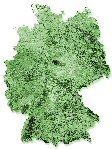|

���

���

���

���

���

���
 |
 Germany
offers a variety of landscapes from the coast in the north to the
Bavarian Alps in the south.� The country boasts a multitude of
historical towns and cities, romantic castles, and excellent
museums.� The tourism infrastructure is well developed and most
of the people speak English.� Germany
offers a variety of landscapes from the coast in the north to the
Bavarian Alps in the south.� The country boasts a multitude of
historical towns and cities, romantic castles, and excellent
museums.� The tourism infrastructure is well developed and most
of the people speak English.�
To learn more about German cities, castles, and festivals, take a
look at our Germany map and travelogues. |
|
Our Favorite
Germany Vacation Destinations |
|
US MILITARY TIPS
US Air Force |
US Army |
US
Navy | US Marine Corps
Berlin | Heidelberg |
Frankfurt | Munich | Stuttgart
PCSing or going on TDY to Germany?
Use this page as
your guide!
CONUS AND OCONUS COLA
|
Military Finance is always confusing,
and this is especially true when moving overseas.� Read our
Military Finance Tips and Essential Information to ensure to find out
more about your Military Money Matters.� Armed with this
knowledge, you can protect your interests and ensure that you get
everything that you are entitled to.
You can find out how much Overseas COLA you are authorized at your specific duty station by visiting
the
OCONUS COLA Rate
Webpage.
COST OF LIVING ALLOWANCE
Cost Of Living Allowance (COLA) is an allowance paid to service
members stationed overseas in high cost areas (including Alaska and
Hawaii).�
The fundamental goal of CONUS COLA is to compensate servicemembers for
the high cost of living at certain duty stations.� COLA rates are
based on a servicemember's pay grade, years of service, and number of
dependents.�
You will only receive COLA overseas if you are assigned to an area
where the cost of living is higher than it would be in an average area
in the United States.� If the cost of living at your overseas
station is the same as or lower than the average in the US, you will
not receive any COLA.
COLA rates vary from station to station, even within a specific
country, and you can find out how much Overseas COLA you are authorized at your specific duty station by visiting
the
OCONUS COLA Rate
Webpage.
CALCULATING COST OF LIVING ALLOWANCES
The Defense Finance Accounting Service calculates the cost of living
in a particular area by using two surveys: the Living Pattern Survey
and a Retail Price Schedule.�
The Living Pattern Survey indicates how much servicemembers purchase
at on post facilities, and how much they spend off post at local
stores.� The survey produces an average for a specific area.�
For example, in a specific area the survey may should that
servicemembers but half of their products on post, and half on the
local economy.� This is only an average and may not apply to all
servicemembers within that area.
Using this information and the Retail Price Schedule, shoppers will
price 120 goods and services, everything from auto repair to zucchini,
to compare their prices with equivalent goods and services in the US.�
If the overseas costs are higher than in the US, a COLA equal to the
difference is paid.
When changes in spending patterns occur because of changes in the
exchange rate, the Living Pattern Survey will be updated.� The
opening/closing of a commissary or an exchange may also prompt an
update to the Living Pattern Survey.
CIVILIAN COLA
Civilians do not use the same cost of living allowance formula as
Uniformed Service Members.� Civilian COLA is calculated by the
State Department, and civilians do not receive an allowance unless the
cost of living for a specific area is at least 5% higher than in
Washington, D.C.� This is as opposed to the Department of Defense
COLA formula which compares costs with an average US city.� The
US capital is an expensive city, so many civilians living in high cost
areas overseas may not be eligible for COLA.
ON POST VS
OFF POST HOUSING
You will receive less COLA if you live on post than you would if you
lived off post.� This reduction in COLA reflects your lower
living expenses.� Overseas Housing Allowance, however, is completely independent
from COLA and the amount you receive in COLA will not affect your OHA.
CHANGES IN COLA RATES
The Per Diem Committee in the Defense Finance Accounting
Service monitors the exchange rates between local currency and US
currency throughout the year.� Changes to an area's COLA are made
along with changes to the exchange rate to maintain your purchasing
power overseas.�
The committee adjusts the COLA rate as often as possible and can even
adjust it every day.� These changes, however, will not have an
immediate impact on your paycheck.� It takes time for the
Department and Defense Finance and Accounting Service to chart
currency movements, set the COLA, and then distribute the money via
payrolls.�
In other words, the COLA rate is always playing catch up with the
dollar's movement in value against other currencies.� On the
reverse side of it, if the dollar rebounds, it will again take some
time for servicemembers to see a reduction in their COLA.
In the short term, servicemembers may see big fluctuations in the US
dollar's buying power.� But over time, COLA adjustments will
offset those changes and a servicemember's purchasing power will
remain steady.
SAVE YOUR COLA!
For the individual servicemember, COLA is a great addition
to any paycheck.� You can increase your saving by forcing
yourself to purchase as many goods as possible on post, thereby saving
your COLA money.�
� |
|
DAMAGED
SHIPMENT?
SEE OUR GUIDE TO
CLAIMS FOR LOSS/DAMAGE TO HOUSEHOLD GOODS/BAGGAGE |
|

���
 ��� ���

���
 ��� ���
 ��� ���

 |